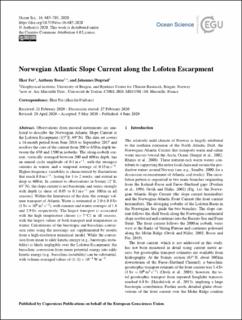Norwegian Atlantic Slope Current along the Lofoten Escarpment
Journal article, Peer reviewed
Published version

View/
Date
2020-06Metadata
Show full item recordCollections
- Geophysical Institute [1198]
- Registrations from Cristin [9791]
Original version
doi.org/10.5194/os-16-685-2020Abstract
Observations from moored instruments are analyzed to describe the Norwegian Atlantic Slope Current at the Lofoten Escarpment (13∘ E, 69∘ N). The data set covers a 14-month period from June 2016 to September 2017 and resolves the core of the current from 200 to 650 m depth between the 650 and 1500 m isobaths. The along-isobath current, vertically averaged between 200 and 600 m depth, has an annual cycle amplitude of 0.1 m s−1, with the strongest currents in winter, and a temporal average of 0.15 m s−1. Higher-frequency variability is characterized by fluctuations that reach 0.8 m s−1, lasting for 1 to 2 weeks, and extend as deep as 600 m. In contrast to observations in Svinøy (2∘ E, 63∘ N), the slope current is not barotropic and varies strongly with depth (a shear of 0.05 to 0.1 m s−1 per 100 m in all seasons). Within the limitations of the data, the average volume transport of Atlantic Water is estimated at 2.0±0.8 Sv (1 Sv =106 m3 s−1), with summer and winter averages of 1.6 and 2.9 Sv, respectively. The largest transport is associated with the high temperature classes (>7 ∘C) in all seasons, with the largest values of both transport and temperature in winter. Calculations of the barotropic and baroclinic conversion rates using the moorings are supplemented by results from a high-resolution numerical model. While the conversion from mean to eddy kinetic energy (e.g., barotropic instability) is likely negligible over the Lofoten Escarpment, the baroclinic conversion from mean potential energy into eddy kinetic energy (e.g., baroclinic instability) can be substantial, with volume-averaged values of (1–2)×10−4 W m−3.
